Accounting Midterm 1
1/112
There's no tags or description
Looks like no tags are added yet.
Name | Mastery | Learn | Test | Matching | Spaced |
|---|
No study sessions yet.
113 Terms
Reporting Process
Public companies are required to file certain reports with the Securities Exchange Commision (SEC)
10-K: audited annual financial statements and footnotes
10-Q: unaudited (but is reviewed) quarterly financial statements and footnotes
8-K: current events report–filed often for various types of events (restructuring, delisting from an exchange, change in fiscal period)

* some people may choose a different fiscal beginning and end than the calendar year. Retailers have a fiscal period go from 2/1 to 1/31
* They want people to have time to return their holiday shopping to capture the true economic value of their fiscal period
* Financial statements
* Footnotes (explain how the firm came up with the numbers reported in the financial statements)
* Managements’ discussion and analysis (talks about what their company does in their industry, their strategy and opinions, etc)
* Audit opinion
Financial Statements
Balance Sheet
A snapshot of what the firms own and owes at a given point in time
“As of 12/31 2022, this is what we have”
Income Statement
A report of the economic performance of the firm over a time period (quarterly, annually, etc)
“For the year ended 12/31/22”
Statement of stockholders’ equity
A report of transactions with owners over a time period
“For the year ended 12/31/22”
Statement of cash flows
A report of sources and uses of cash over a time period
“For the year ended 12/31/22”
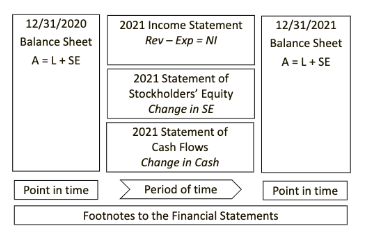
* assets= liabilities + stockholders’ equity
* This is accounting law
* If this equation doesn’t balance, check your work
* A resource owned by the entity
* A probable future benefit
* Ex: cash, property,
* A future obligation
* Ex: financing by creditors (ex: debt)
Stockholders’ Equity is:
A = L + SE
Owners' portion of assets after the liabilities have been paid
Financing from owners of the business (common stock) and reinvested earnings (known as retained earnings)
Aka owners’ equity, net worth, book value, net assets, etc.
Ex: stockholder’s equity could be what we own of a house minus what we owe to the bank

* Cash and cash equivalents: e.g. treasury bills (gov’t loan), certain short-term securities, that are “as good as cash”
* The gov is good at paying those back
* Land property and equipment, net: e.g. buildings owned, table displays, cash registers, etc
* Aka property, plant, equipment (PPE)
* Operating lease right of use assets:
* buildings that they rent
* Good will
* Intangible asset earned through acquisitions
* Merchandise inventory
* What the company sells.
* E.g. shirts, shoes, jewelry
* Accounts receivable, net
* E.g. a payment they expect to be coming from someone who owes you money – a venmo request
* Prepaid expenses and other
* E.g., rent
* Pay rent for 5 months out. It’s an asset because you have the rights to it and it’ll bring you benefit in the future (like housing)
what is prepaid rent classified as?
an asset
* Current assets;
* Converted to cash within one year
* Non current assets
examples of liabilities
wages
accounts payable
debt
lease
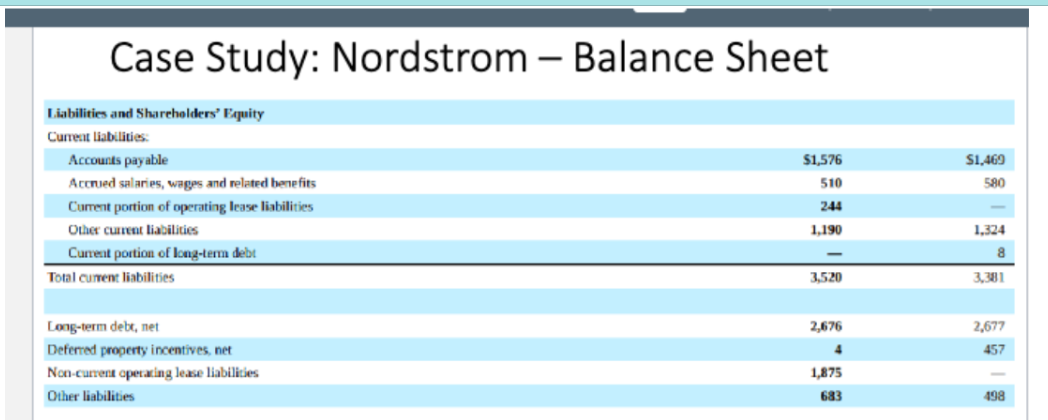
* Accounts payable
* E.g., outstanding venom request that needs to be paid
* We have an IOU to pay
* Ex: paying our suppliers on a payment system
* Accrued salaries, wages and related benefits
* Eg: salaries that need to be paid
* Accrued means accumulated, come about over time
* So accrued salaries means accumulated salaries that need paid
* Long term debt is split into:
* Current portion of Long term debt
* Something we owe to the bank
* E.g. portion of the loan from the bank – due in 6 months
* Noncurrent portion of long term debt
* E.g. loan from the bank – due in 5 years
* Non current operating lease liabilities
* Talked about later
* Other current liabilities and other liabilities
* 2 main owner’s equity accounts
* 1. Common stock
* Aka contributed capital
* Contributions of cash or resources in exchange for an ownership stake in the firm (money from the investors)
* Increases when the company sells shares
* 2. Retained earnings
* Aka “earned capital”
* Accumulated net income/loss that hasn’t been returned to shareholders through dividends
* Earned over time
* Sitting in the bank
retained earnings
Aka “earned capital”
Accumulated net income/loss that hasn’t been returned to shareholders through dividends
Earned over time
Sitting in the bank
What is retained earnings known as if it’s negative
accumulated deficit
* Aka contributed capital
* Contributions of cash or resources in exchange for an ownership stake in the firm (money from the investors)
* Increases when the company sells shares

* Common stock: contributed capital
* Accumulated deficit=retained earnings
* Called deficit because it has a negative amount
* Retained earnings if positive
* Total liabilities and shareholders’ equity will equal total assets
* Because A = L + SE
revenues vs assets
revenues are paid to you by the customer for your product
assets are any other money or value earned from nonbusiness transactions
* 1. Checking Account
* Asset
* Something we own that brings us benefit in the future
* 2. Land the ice cream shop is built on
* Asset
* Something we own that brings us benefit in the future
* 3. Common stock
* Stockholders’ equity
* Contributed capital paid by investors for ownership in the company
* 4. Accounts payable owed to dairy provider
* Liability
* “payable”
* 5. Accounts receivable front target
* Asset
* IOU
* 6. Retained earnings
* Stockholders’ equity
* Earned capital that they’ve made over time, stored in the bank
* 7. Waffle cone inventory
* Asset
* Reports revenues and expenses to illustrate the profitability of the company over a period of a time (10-k is a year, 10 q is a quarter, etc)
* **Revenues minus expenses = net income**
* Revenues: amounts expected to be received from a customer for goods or services during the period
* Accrual accounting (when we earned them), distinction from cash accounting. When we acquired them but we didn’t use it or pay it in that same period
* RECORDING THINGS WHEN THEY HAPPEN, NOT WHEN CASH CHANGES HANDS
* Expenses: amounts used to earn revenues during the period
* Costs incurred to generate revenues
* Ex: wages, rent, utilities
* Accrual accounting (when we earned them), distinction from cash accounting. When we acquired them but we didn’t use it or pay it in that same period
* RECORDING THINGS WHEN THEY HAPPEN, NOT WHEN CASH CHANGES HANDS
* Net income: aka “bottom line,” or “profit” or “earnings”
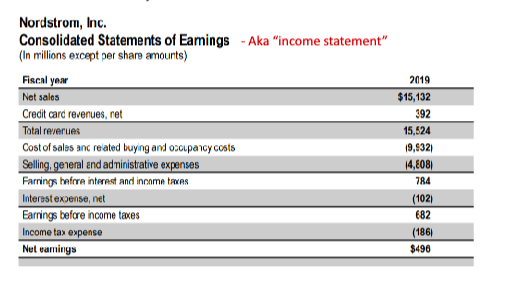
* Consolidated statements of earnings = income statement
* Net sales
* Of clothing, shoes, etc
* Credit card revenues, net
* From nordstrom credit cards
* Cost of sales (aka cost of goods sold) and related buying and occupancy costs selling, general and administrative expenses
* Costs incurred to generate revenues
* Cost of sales is inventory and products
* Selling, general and administrative expenses is non product related costs
* Interest expense, net
* Costs associated with debt financing
* Net earnings
* Net income, bottom line, earnings, profits
* Reports inflows of resources from investors to the business and outflows from the business to investors over a specified period of time
* Provides extra details on stockholders’ equity section of the balance sheet
* **(Beginning balance + contributed capital changes + earned capital changes (i.e. retained earnings)) = ending balance**
* **Beginning retained earnings + net income (-net loss) minus dividends = ending retained earnings**
* Retained earrings
* Aka “earned capital”
* **Accumulated net income/loss that has not been returned to shareholders through dividends**
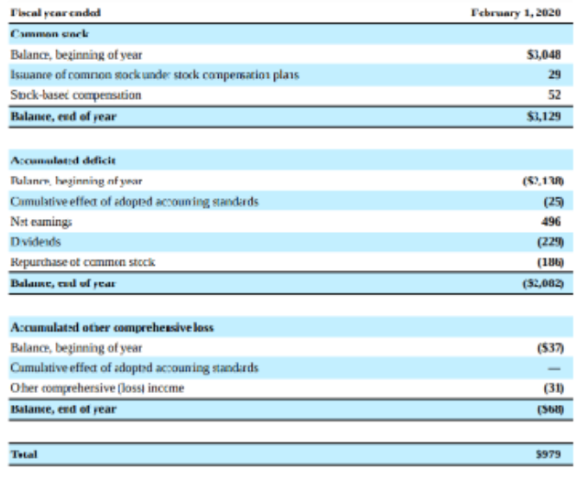
* Issuance of common stock under stock compensation plans
* Issued as compensation
* Accumulated deficit
* Aka retained earnings if positive
* Cumulative effect of adopted accounting standards
* Tie to income statement
* Add net earnings, subtract dividends, repurchase of common stock affects net earnings
* Total equity should tie to the amount on balance sheet
* Reports sources of cash inflows and outflows over a period of time
* 3 categories
* Change in cash flow from operating activities
* E.g. selling product/service
* Day to day
* Change in cash flow from investing activities
* e.g. , equipment
* Make Expenditures to grow our business
* Ex: capital expenditures
* Investing activities related to long term assets
* Change in cash flow from financing activities
* E.g. loan, cash from investors
* Transactions with shareholders or people who lend money
* HOW WE FINANCE THE COMPANY
* Add the 3 changes together to arrive at the total change in cash
* **Ending cash should tie to balance sheet**
* current asset
* common stock
* equity
* accounts payable
* current liability
* inventory
* current asset
* accounts receivable
* current asset
* long term debt
* long term liability
* other assets
* current asset
* interest payable
* current liabiility
* retained earnings
* equity
* prepaid expense
* current asset
* net income
* income statement
Beginning balance retained earnings plus net income minus dividendeds equals ending retained earnings
beginning balance retained earnings = total equity minus common stock from 2020, which is 10,000-5000=5000
net income=revenue minus expenses=350,000-275,000=75,000
ending retained earnings=Assets minus liaibilites minus common stock (total equity minus common stock but we don’t have that)= 100,000-75,000-5,000=20,000
5000+75,000-DI=20,000
DI=60,000
how is a gift card recorded in financial statements?
as “stored value card” recorded as a liablity and current portion of deferred revenue
reason total revenues and total expenses would increase
customers are buying more so you have to buy more as a company, and you are earning more revenue with raised prices
* Baking equipment
* assets
* Retained earnings
* Equity
* Aka earned capital
* Note payable
* liability
* Accounts receivable from target
* asset
* Prepaid expense to smith brothers farms for milk used in the tres leches
* Asset
Difference between note payable and account payable?
Notes are long term, accounts payable are short term
Notes payable are to a creditor, while accounts payable go to a vendor or supplier
NOTES PAYABLE ARE FOR LOANS, ACCOUNTS PAYABLE ARE FOR INVENTORY
* Financing
* Obtaining funds for the business
* Can be debt or equity
* Investing
* Growing and setting up the business
* Operating
* Running the business
* Day to day
* In the U.S. the “Financial Accounting Standards Board” (FASB) writes the accounting rules known as the “Generally Accepted Accounting Principles” (GAAP).
* • There is a push to have an international set of accounting standards. Many countries, including the EU, use IFRS (International Financial Reporting Standards).
* How do we get to those ending balances on the financial statements?
* 1. Identify transactions
* Need to pay attention to what perspective we are thinking about. Normally we are thinking about a company’s perspective
* 2. Determine the effect on the accounting equation and all its parts (A = L +SE)
* 3. Determine whether to debit or credit impacted accounts
* Debits and credits are tools in recording the transactions
* 4. Record transaction in the journal
* 5. Post transaction to the ledger
* Summary of transactions
* 6. Prepare a trial balance
* Summary of accounts
* 7. Prepare financial statements
coffee shop example of recording transactions and it’s steps
Assets:
Inventory
Loans
Cash
Identify transactions
Jan 1. Owners contribute $4,400 cash to form the store, they receive 100 shares of common stock
Jan 1. Purchase pastry make equipment for $3200 and purchase inventory for $1200
Jan 1. Receive $26000 loan to start a business
2. Determine Effect on Accounting Equation
To preserve this, for every transaction:
Change in assets = change in liabilities plus change in equity
Entries on left = entries on the right
Every transaction has a dual effect: double entry bookkeeping
When determining the effect on the accounting equation, ask yourself:
Accounts: which accounts are affected? Create as many individual asset and liability accounts as needed
Direction: decrease or increase? More cash or less cash?
Amount: by how much?
Ex: determine the effect on accounting equation for: Lauren and Jeff contribute $4,400 to form Fox in the Snow. They each receive 100 shares of common stock (no par value)
Accounts: cash (A) and CS (E)
Direction: cash goes up, CS goes up
Amount: 4,400
4400 of cash = 4400 CS
Ex: determine the effect on accounting equation for: Purchase pastry making equipment for $3,200 cash and purchase inventory (chocolate, coffee beans, sugar, butter, and coconut) for $1,200 cash.
Accounts: cash (A), inventory (A), equipment (A)
Direction: cash goes down, inventory goes up, equipment goes up
Amount:
-4400 cash + 1200, +3200 = 0 + 0
Ex: determine the effect on accounting equation for: Receive $26,000 cash from the Buckeye Accelerator program to help start the business. For class, let’s assume this $26,000 is a loan
Accounts: cash (A), loan/note payable (L)
Direction: cash goes up, loan/note payable goes up
Amount
+26,000 = -26000 + 0
Step 3: Determine whether to debit or credit each account
Changes in assets = changes in liabilities + change in equity
Entries on left = entries on the right
Debits = credits
Debits are everything on the left, credits are everything on the right
Signal increases and decreases in the account
Increases are everything on the far outside of the t equation
So for assets, increase on the left, for liabilities and equity, increases on the right
Are these increases or decreases
Debit cash
Increase
Credit note payable
increase
Credit supplies
decrease
Debit retained earnings
decrease
Credit common stock
Increase
Step 4: Record Transactions in the Journal
Journal: chronological record of all transactions affecting a firm
Are formal means of recording transactions using debits or credits
Include date, reference number, accounts impacted, by how much, and how they’re debited or credited
Debits appear first
debits=dr.
creditors=cr.
Ex: Lauren and Jeff contribute $4,400 to Fox in the Snow. They each receive 100 shares of common stock (no par value)
Ex: Purchase pastry making equipment for $3,200 cash and purchase inventory for $1,200 cash
Date
Ref #
Accounts
Debit
Credit
1/1
1
Equipment (A+)
Inventory (A+)
Cash (A-)
\n
3200
\n
1200
\n \n \n \n
4,400
Received $26,000 cash from the Buckeye Accelerator program to help start the business. For class, let’s assume this $26,000 is a loan.
Date
Ref #
Accounts
Debit
Credit
1/1
1
Cash (A+)
Notes payable (L+)
26,000
\n
26,000
Step 5. Post transaction to the ledger
Summary of transactions
A ledger
A system that contains all the t accounts
The process of transferring the debits and credits from the journal to the ledger is called posting
What is a t account?
A visual representation of each account
Each type of asset, liability and equity has its own account
Debits on the left, credits on the right
Contains all the journal entries
Shows the running total in each account
Debit accounts have ending balance on the left, credit accounts have ending balance on the right
Ex:
SEE NOTEBOOK FOR EXAMPLE
Prepare a trial balance
Summary of accounts
The trial balance aggregates the ending balance of all T-accounts. We will use the trial balance to create financial statements
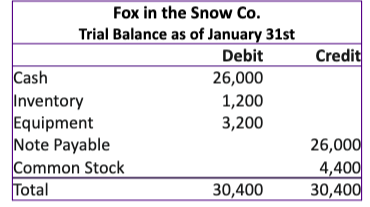
how would you classify a loan
a notes payable or a loan payable
debits and credits
debits on the left (increase for assets, decrease for everything else)
credits on the right (decrease for assets, increase for everything else)
what is a journal
Journal: chronological record of all transactions affecting a firm
Are formal means of recording transactions using debits or credits
Include date, reference number, accounts impacted, by how much, and how they’re debited or credited
Debits appear first
debits=dr.
creditors=cr.
Ex: Lauren and Jeff contribute $4,400 to Fox in the Snow. They each receive 100 shares of common stock (no par value)
ledger
Summary of transactions
A ledger
A system that contains all the t accounts
The process of transferring the debits and credits from the journal to the ledger is called posting
What is a t account?
A visual representation of each account
Each type of asset, liability and equity has its own account
Debits on the left, credits on the right
Contains all the journal entries
Shows the running total in each account
Debit accounts have ending balance on the left, credit accounts have ending balance on the right
Ex:
Trial Balance
Summary of accounts
The trial balance aggregates the ending balance of all T-accounts. We will use the trial balance to create financial statements
* What’s wrong with this example?
* Nordstrom buys $1,000 of shirts from Nike to sell at Nordstrom’s downtown location. It will pay Nike next month. The beginning balance in its accounts payable account is $50. Nordstrom makes the following JE: Dr. Equipment 1,000, Cr. accounts payable 1,000
Financing with stock and par value and APIC
Each share of stock is legally required in certain states to have a minimum price listed on it, known as a par value. A Par value is completely unrelated to the actual market value of the stock
No par value: common stock account is credited for the amount of cash received from investors
Debit cash, credit common stock
Price per share times number of shares for both credit and debit
Par value: common stock is credited for the par value and any additional amount paid by the investor is credited to additional paid in capital (APIC)
Debit cash: price per share * number of shares
Credit common stock: par value * number of shares
Credit APIC: the difference
Ex:
DoorDash had its IPO (Initial Public Offering) in December, 2020. It issued 33 million shares at $102 per share. If the stock had no par value, the journal entry is:
Dr. Cash (A+) = 33 million * 102 =$3,366 million
Cr. Common stock (E+) = $3,366 million
DoorDash stock actually had a par value of $0.00001 per share, so the entry is
Dr. Cash (A+) = $3,336 million
Cr. Common Stock (E+) = 0.00001 * 33 million = $330
Cr. APIC (E+) = 3,336 million – 330 = $336,599,670
* As a stockholder, one benefit is that you could receive a portion of what the company earns in a form of cash dividends
* Beginning R/E + Net income – Dividends = Ending R/E
* Benefit you can receive as investors. You get paid cash from the companies, that’s a dividend
* Come out of retained earnings
* Dividends are paid out of retained earnings, the journal entry when dividend is declared is
* Dr. Retained earnings…(E-)....$
* Cr. Dividend payable…..(L+)
* When the dividend is paid
* Dr. dividend payable….(L-).... canceling out the credit on declaid day
* Cr. Cash….(A-).....
* When dividends are paid and declared are on different days

Dividends example
Declaration date of November 16, 2020
Dr Retained Earnings (E-): 4.4 B
Cr Dividend Payable (L+): 4.4 B
Payment day of december 11, 2020
Dr. Dividend Payable (L-): 4.4 B
Cr Cash (A-): 4.4 B
Recording Transaction example when you borrow $10 to buy a $9 burrito
1. You borrow $10 from a friend and buy a $9 burrito with it
2.
Assets= +10 cash +$9 burrito -$9 cash
Liability = Note Payable +10
3/4
Asset debit of $10 cash and $9 burrito and credit $9 cash
Liability credit of $10 NP
5
Create 3 tables
1. Cash (A)
1. Debit 10
Credit 9 2.
Ending balance: 1
2. Burrito (A)
Credit 9 2.
Ending balance: 9
3. N/P (L)
Credit 10 1.
Ending balance: 10
6.
7.
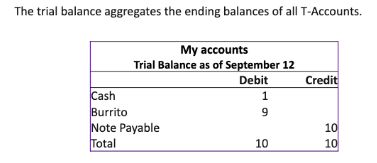
* Company issues 100 shares of common stock. The par value of the stock is $0.01 and the stock is issued at $17/share. Record the journal entry for this transaction
* Debit Cash: 17\*100 = 1700 (A+)
* Credit common stock (100\*0.01) = 1 (SE+)
* Credit Additional Paid in Capital 1700-1 = 1699 (SE+)
* If there’s no par value, just debit cash and credit common stock, no APIC
* Company declares a dividend for common stockholders of $0.50 per share on September 30 to be paid by November 1. There are 100 shares outstanding on the date of record
* Date of record: snapshot of who is a shareholder as of this date
* November 1: payment date
* September 30: declaration date
* Pay dividends out of retained earnings
* On September 30
* Debit retained earnings (E-) = $50
* Credit dividend payable (L+) = $50
* On November 1
* Debit dividend payable (L-) = $50
* Credit cash (A-) = $50
Entry for: “Austin wins a cash prize of 4,500. He decides to contribute the cash to create a company in exchange for 100 shares of common stock (par value of $1 per share)”
dr. cash (a+) 4500
cr. common stock (SE+) 100
cr additional paid in capital (SE+) 4400
Every income starts with nets sales (or revenues)
Then cost of sales (what they paid for inventory)
Then Gross Margin (of Gross Profit) = Revenues Cost of Goods Sold
Net sales minus cost of sales
Tells you about the company’s markup
Then is expenses
Then selling general and administrative expenses (cost of running business)
Depreciation amortization (has to do with fixed assets)
Operating income
Pretax earnings
Net earnings
Income statement accounts you see the most
Revenues
Expenses
gains/losses
revenues and expenses inside of the balance sheet equation
Assets = liabilities plus stockholder’s equity
Equity is made up of retained earnings (ending retained earnings = beginning retained earnings plus net income minus dividends) and contributed capital (common stock and APIC)
How all types of accounts fit into A = L + SE
Common stock and retained earnings debit when decreasing and credit when increasing
Revenues debit when they decrease and credit when they increase
Expenses DEBIT WHEN THEY INCREASE AND CREDIT WHEN THEY DECREASE
True or false: a transaction that impacts the income statements always impacts the equity section of the balance sheet too
True, net income falls under retained earnings which is under the equity section
Everything on the income statement comes down to net income
cost of goods sold
debiting stock holders equity because expenses increased due to crediting and getting rid of inventory
is an expense account representing the amount the business paid for inventory that it has sold.at it has sold.
if inventory is worth $200 and it gets sold
dr COGS 200
cr inventory 2000
Examples of revenue and expenses in the steps of recording transactions
Recording transactions steps
1. Identify transactions
1. On 2/28 they paid 2,000 to rent a storefront for the month of february
Debit rent expense (+exp, eq-) 2000
When expenses go up, net income goes down, retained earnings goes down, and stockholders equity goes down
Credit cash (a-) 2000
2. On 2/28 we prepaid rent for March and April for 4000
Debit Prepaid rent (a+) 4000
Credit cash (a-) 4000
3. On 2/10: sold pastry making tours for $50
When revenue goes up net income goes up retained earnings go up and stockholders equity goes up, so they all credit
Debit cash (a+) 50
Credit tour/service revenue (rev+,eq+) 50
4. Sold coffee and pastries costing 1200 to customers for 3500
+3500 cash (a+)
-1200 inventory (a-)
+3500 revenue (+re)
-1200 expenses (-re)
Sales side
Dr. cash (+A)
Cre. sales revenue (+REV, +NI, +SE)
Costs side
Dr. Cost of goods sold (+EXP, -NI, -SE)
Cr Inventory (-A)
Accrual vs cash based accounting
Accrual accounting doesn’t equal cash accounting
Cash accounting: records inflows and outflows of cash
Cash inflows = revenues
Cash outflows = expenses
So all the cash even before the expense is incurred?
Accrual Accounting: records transactions
When revenues are earned
When expenses are incurred
Not all of the total cash?
KEY DIFFERENCE IS TIMING
Cash accounting isn’t allow for public companies
Cruise Example
In 9/22 you book a $5000 cruise for 3/23
Can it be included in the company’s income statement for 2022?
Yes, under cash accounting it’s revenue
No, Under accrual accounting it’s not revenue until March 2023
Recording Revenue:
Revenue recognition principle
Revenue should be recognized when the performance obligation has been satisfied. A company satisfies its performance obligation by performing a service or delivering a good to a customer
Ex: for Nordstrom: selling the clothes
Ex for EA Games: when the person receives the game
Facebook: running ads
Revenue Recognition: 5 Step process
Apple inc. example: you order the iphone 14 with applecare for 12 months
1. Identify the contract between the company and the customer
Iphone 14 with 12 months warranty
2. Identify the performance obligations
To deliver the phone and provide the warranty
3. Determine the transaction price
1500
4. Allocate the transaction price to the performance obligation
Phone is 1300 and apple care is 200
5. Recognize revenue when each performance obligation is satisfied
Ex: In april, Delta sells 4 tickets for a flight to Hawaii from Columbus for the 4th of July. Delta’s year end is June. When is ticket revenue recognized under the cash method. What about the accrual method?
Cash = April
Accrual = July
Recording Expenses: Matching Principle
Under teh accrual method, expenses should be recognized in the same period as the revenues that they help to generate
Ex: when nordstrom sells clothes to a customer, revenue is earned and there are costs related to generating that revenue that need to be matched such as
Salaries and wages during that period
Cost of the clothes sold during that period
Utilities and rent on building during that period
Ex: In February, Buckeye donuts paid for February’s rent of 2,000 and March’s rent is 2500. How much rent expense will Buckeye donuts record in february
2000. Associated with the amount of revenues incurred in february
2500 won’t be recognized till march
Relevance vs. Faithful representation
Accrual accounting rules make financial statements more relevant but often sacrifice faithful representation
Relevance: information is more useful for understanding the firm and future performances
Faithful representation: the info more faithfully rerpesents the economics of the transactions; it is complete, neutral and erro free. This is harder to do with many assumptions and estimates
Relevance vs Faithful representation
Cash based accounting system
Objective and simple
Faithful representation – cash is what it is
Accruals based accounting system
More assumptions and complexity
More relevant to economics of the firm
But accruals allow for more discretion
Discretion + incentives = manipulation
Is accruals based accounting actually more useful than cash based accounting?
Revenues
are defined as increases in assets or settlements of liabilities from the major or central ongoing operations fo the business
Proceeds from goods sold or services rendered
Expenses
are defined as decreases in assets or increases in liabilities from ongoing operations incurred to generate revenues during the period
Expenditures (outflows) incurred to generate revenues
8/18: Dr Accts Receivable (a+): 2000
Cr. revenue (rev+, eq+): 2000
Dr. Cost of goods sold (exp+, eq-): 1000
Cr. Inventory (a-): 1000
9/25: Dr cash (a+): 2000
Cr accounts receivable (a-): 2000
4/30: Dr. insurance expense (exp+, eq-): 250
Dr. prepaid insurance (a+): 250 (has future benefit)
Cr cash (a-): 500
Assets: -250
Liabilities:
Equity: =net income = -250
Revenue: 0
Expenses: 250
net income: (0-250)=-250
true or false: the payment of dividends decreases cash and increases expenses?
False. Paid to shareholders while (financing) expenses are the costs of operating the business. Both reduce retained earnings though
Dividends and expenses both reduce retained earnings, but expenses relate to operating our core business whereas dividends are amounts returned to shareholders. Dividends do not appear on the income statement
Aren’t an expense because they are a part of equity
how to record: “a company’s freeze drier malfunctions. The owner hires a mechanic to repair the freeze drier, and is invoiced 350 for the service)
dr. operating expense (exp+, rev-) 350
cr. accounts payable (L+) 350
how to record: “company pays 3600 in advance for 2 year insurance policy”
dr. prepaid insurance (a+) 3600
cr. cash (a-) 3600
how to record: “company receives software bill of $40, which they pay in cash”
dr. operating exp (exp+, eq-) 40
cr. cash (a-) 40
how to record: “pays rent for this month and for next month totalling 1000”
dr. prepaid rent (a+) 500
dr. rent (exp+, eq-) 500
cr. cash (a-) 1000
how to record: “company receives 20,000 from backers, meaning his kickstarter goal is fully funded. Owner will deliver product evenly to customers over the next 10 months”
dr. cash (a+) 20000
cr. unearned revenue (L+) 20000
unearned revenue is like deferred revenue, like a gift card
Should’ve recorded:
(since wages were earned but not yet paid)
Dr. wage/salaries expense (exp+,eq-)
Cr. wages payable (L+)
Assets are the same. Liabilities are understated. Equity is overstated.
Adjusting Entries
TRYING TO GET THE STATEMENTS TO REFLECT THE TRUE ECONOMIC SITUATION
When cash is exchanged at a different time than the expense/revenue, the accrual method requires two journal entries
One for the cash exchanging hands and
One for the revenue or expense recognition
The goal
Make sure revenue is recorded when earned
Make sure expenses are recorded when incurred to generate revenue
Make sure assets and liabilities are reported at the amount that reflects the economic situation
Situations requiring adjusting entries
1. Prepaid expenses (aka deferred expenses)
Cash has been paid but expense hasn’t been incurred
2. Unearned revenues (deferred revenues)
Cash has been received from customers but revenue hasn’t been earned
3. Accrued expenses
Expense has been incurred but hasn’t been billed and paid for (salaries)
Ex: Salaries: the work has been done and cash is earned but you don’t get paid for 2 weeks
4. Accrued revenues:
revenue has been earned, but you haven’t billed and received payment from the customer yet
Ex: Fulfilled performance obligation but haven’t gotten the cash yet
Adjusting entries – tips
1. Cash is never part of the journal entry. Cash has either already been paid or will be paid in the future
2. All adjusting journal entries hit at least once balance sheet account (A, L, E) and one income statement account (Rev, Exp)
3. Ask yourself – how can I make this expense or revenue accurately represent what happened in this accounting period?
Deferred expenses – depreciation
Depreciation expense: allocation of the property’s cost over its estimated useful life to the company
Accumulated depreciation: sum of the asset’s depreciation taken to date. Accumulated depreciation is know as a contra account
Contra accounts
1. Always linked to a companion account
2. Always has a balance (debit or credit) opposite that of the companion account
Ex: equipment (A) and accumulated depreciation (XA)
Ex of adjusting entries: prepaid expenses
Feb 9: Dr. Prepaid rent (a+) 4000
Cr. Cash (a-) 4000
AJE: March 31: Dr. rent expense (exp+, eq-) 2000
Cr. Prepaid rent (a-) 2000
AJE: April 30: : Dr. rent expense (exp+, eq-) 2000
Cr. Prepaid rent (a-) 2000
Ex of adjusting entries: deferred expenses
Initially you dr. equipment and cr. cash
The machinery is depreciating
Debit depreciation expense (exp+, eq-)
Cr. Accumulated depreciation (xa+, a-)
Equipment net —> B/S. Value of equipment has decreased to 3,125
Ex of depreciation:
Journal entry on July 1
Dr. equipment (a+) 3500
Cr cash (a-) 3500
AJE Journal Entry on 31
Dr. Depreciation expense (exp+, eq-) (250*.5)
Cr Accumulated depreciation (XA+, A-) (250*.5)
Is it ok that total estimated depreciation over 12 years isn’t equal to the purchase price?
Yes. 250 a year times 12 years = 3000. In some cases you will depreciate the full amount and in some cases you won’t. Yes it may have a salvage value.
Ex:
Supplies. Not considered inventory because napkins are put with each product. Not every customer gets it with their goods
Ex: Adjusting Entry – Supplies
Unadjusted trial balance means: before adjusting journal entries. Before AJE
AJE
Dr. supplies expense (exp+, eq-) 50
Cr. supplies (a-) 50
Deferred Expenses and fraud
Because there is some discretion involved, fraud it possible
What they were doing: spreading cost out over years to inflate income
Dr capitalized asset (a+)
Cr cash (a-) 1 million
—------- dr. dep exp (exp+, eq-) 100k
Cr. a/d (XA+, A-) 100k
What they should’ve been doing
Dr. expense (exp+,eq-) 1 million
Cr cash (a-) 1 million
Ex: Adjusting entries – deferred revenue
3/10: dr. cash (a+) 200
Cr. unearned revenue (L+) 200
AJE: Later in march 3/31: dr. unearned revenue (L-) 50
Cr. service revenue (rev+, eq+) 50
Adjusting entries
Ex: Adjusting entries – accrued expenses
AJE 3/31: dr. salaries expense (exp+, eq-) 400
Cr. salaries payable (L+) 400
Later: dr. salaries payable (L-) 400
Cr. cash (a-) 400
types of accounts payable
Dividends (paying shareholders), accounts (for things like equipment), and salaries payable (paying workers), notes payable (getting cash from someone)
Ex: Adjusting entries – accrued expenses
1/1/Y1: dr cash (a+) 26000
Cr. notes payable (L+) 26000
1/31Y1, 2/28/Y1, 11/30/Y2)
Dr. interest expense (exp+, eq-) 65
Cr. interest payable (L+) 65
12/31/Y2: 26000(*.3)=780/yr, 65 dollars a month
Dr. interest expense (exp+, eq-) 65
Dr. notes payable 26,000
Dr. interest payable 1495 (23 months of interest) (will be 27560 at the end)
Cr. cash (a-)
Ex: Adjusting Entries – accrued revenue
1/1/Y1: dr. notes receivable (a+) 26,000
Cr. cash (a-) 26,000
AJE: 1/31/Y1, 2/28/YR1…11/30/Y2
Dr. interest receivable (a+) 65
Cr. interest revenue (rev+ eq+) 65
12/31/Y2
Dr. cash (a+) 27560
Cr interest revenue (rev+, eq+) 65
Cr. notes receivable (a-) 26000
Cr. interest receivable (a-) 1495(23 months)
Closing the temporary accounts
Balance sheet accounts are permanent
They are cumulative and their balances carry from one period to the next. The ending balance in one period becomes the beginning balance in teh next period
Income statement accounts are temporary
Transfer the balance in each account to retained earnings and establish zero balance to start off the next accounting period
Closing entries close all temporary (income statement) accounts into retained earnings via a journal entry.
• Moves net income into Retained Earnings
• Zeros-out the Income Statement accounts to begin again next period
Ex:
Literally just put the same amount in for the opposite side of each account. Debit revenue and credit expenses.
Dr. sales revenue 10,000
Dr. service revenue 50
Cr COGS 3200
Cr wage expense 400
Cr rent expense 2000
Cr interest expense 65000
Cr depreciation expense 25
Our debits will not equal our credits, so put the remaining amount in retained earnings
Cr retained earnings 4360, also the same as our net income for the period
Retained earnings becomes 4535
Ex:
Dr. revenue 10,000
Cr cogs 5000
Cr rent exp 500
Cr wage exp 1000
Cr RE 3500
What is equipment and land classified as?
long term asset
Dragon Company pays dividends of $500 in Year 1. The dividends were declared in Year 0. How does the accounting equation change because of the journal entry for the payment in Year 1?
Assets decrease by 500, Liabilities decrease by 500.
originally under accounts payable when they are declared, that’s why liaiblities decrease, you get rid of the accounts payable
Indicate whether each transaction would increase (I), decrease (D), or have no effect (NE) on the total assets of the company.
Borrowed money from the bank on a Notes Payable | I |
Purchased inventory on credit | I |
Purchased inventory with cash | NE |
Paid off an accounts payable to a supplier | D |
Collected cash on accounts receivable | NE |
Issued capital stock in exchange for cash contributed by owners | I |
Loaned money to an employee in exchange for a note | NE |
Declared dividends | NE |